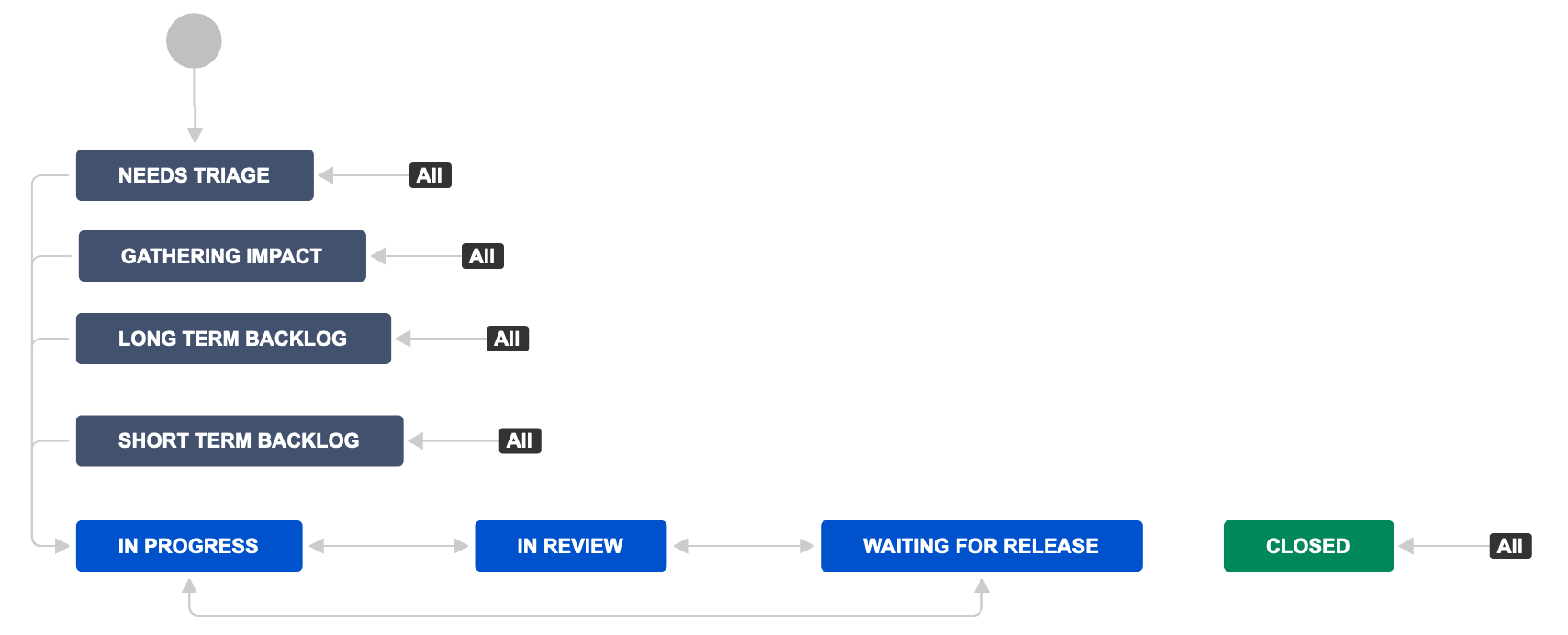Atlassian Cloud Bug Fix Policy
Bug reports
Atlassian Support is eager and happy to help verify bugs—we take pride in it! Create an issue in our support system, providing as much information as you can about how to replicate the problem you're experiencing. We'll try to replicate the bug to verify, and if successful lodge the report for you. We'll also try to construct workarounds if possible.
Search existing bug reports
Use our public issue tracker to search for existing bugs, add your report, and watch the ones that are important to you. When you watch an issue, we'll send you an e-mail notification when the issue's updated.
How we approach bug fixing
Atlassian seeks to target the most critical bugs affecting the widest customer set. Bugs are prioritised based on the the estimated impact to Atlassian users. Most bugs are initially reported at Low priority until they are triaged and the true impact is assessed by Atlassian.
The priorities applied to confirmed bugs are:
Priority 1 - Highest
Your application is degraded. Users aren't able to perform their job function, and no workarounds are available. Typically the most impactful bugs are treated by Atlassian as an incident and can be tracked on https://status.atlassian.com, highest priority bugs are the next most impactful variety of bug.
Atlassian begins work on Highest priority bugs as soon as reasonably possible.
Priority 2 - High
A feature is unavailable, application performance is significantly degraded, or users job functions are impaired.
Atlassian generally seeks to begin work on High priority bugs in the next sprint.
Priority 3 - Medium
The application or specific feature isn't working as expected, but there is a workaround available. Users' experience is impacted, but their job function is not impaired.
Medium priority bugs are typically worked on after all High and Highest priority bugs are resolved and there are no other critical priorities.
Priority 4 - Low
Typically smaller paper cuts such as cosmetic errors, or non-critical functionality not behaving as expected.
Low priority bugs are worked at Atlassian’s discretion, and are typically only fixed if our Developers are already working in that area of the product and are able to easily resolve the problem identified.
About our bug fix workflow
If you watch or mark a bug as affecting your team, it’s useful to understand how we review, prioritize, and resolve them in our public issue tracker jira.atlassian.com.
Here’s the current workflow, and a description of each status.
Workflow Status Definitions
| Workflow Status | Definition | Phase |
|---|---|---|
Needs triage | This issue is waiting to be reviewed by a member of the Atlassian product team. Typically, only recently created issues are in this status. Our product teams review these issues regularly. | Review |
Gathering impact | This issue has been reviewed, but needs more supporting information to gauge the pervasiveness of the problem. | Prioritization |
Long term backlog | A fix for this issue is required, but planned for farther in the future. The issue is less severe or pervasive than other issues. | |
Short term Backlog | A fix for this issue is required, and will be prioritised in the near future. The issue is more severe or pervasive than other issues. | |
In progress | The development team is actively working on this issue. | Implementation |
In review | A fix for this issue has been proposed and is being reviewed and quality-tested by the development team. | |
Waiting for release | A fix for this issue has been implemented and is waiting to be rolled out. | |
Closed | Work on this issue is complete. If the bug has been fixed, the resolution will be ‘Fixed’. If required, code changes are progressively rolled out to the full customer base. If no code changes were required, the resolution will be ‘Duplicate', 'Won't fix', 'Handled by support', 'Timed out', or similar. | Closure |
How to get access to bug fixes
Once a bug fix is written, tested, and verified, we’ll progressively roll it out to your site as soon as we reasonably can - in many cases this will occur within a few days.
Please note the above priorities, timeframes and objectives are intended to provide general guidance on how Atlassian internally handles bugs. Any response times or resolution timeframes in this document are non-binding targets, and do not create any representations, warranties, obligations or liabilities. Your agreement with Atlassian governs any use of the applicable cloud service(s) and any related issues.

